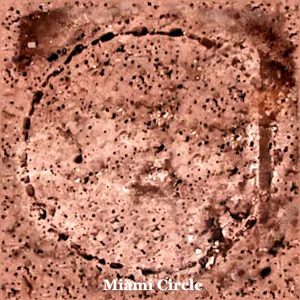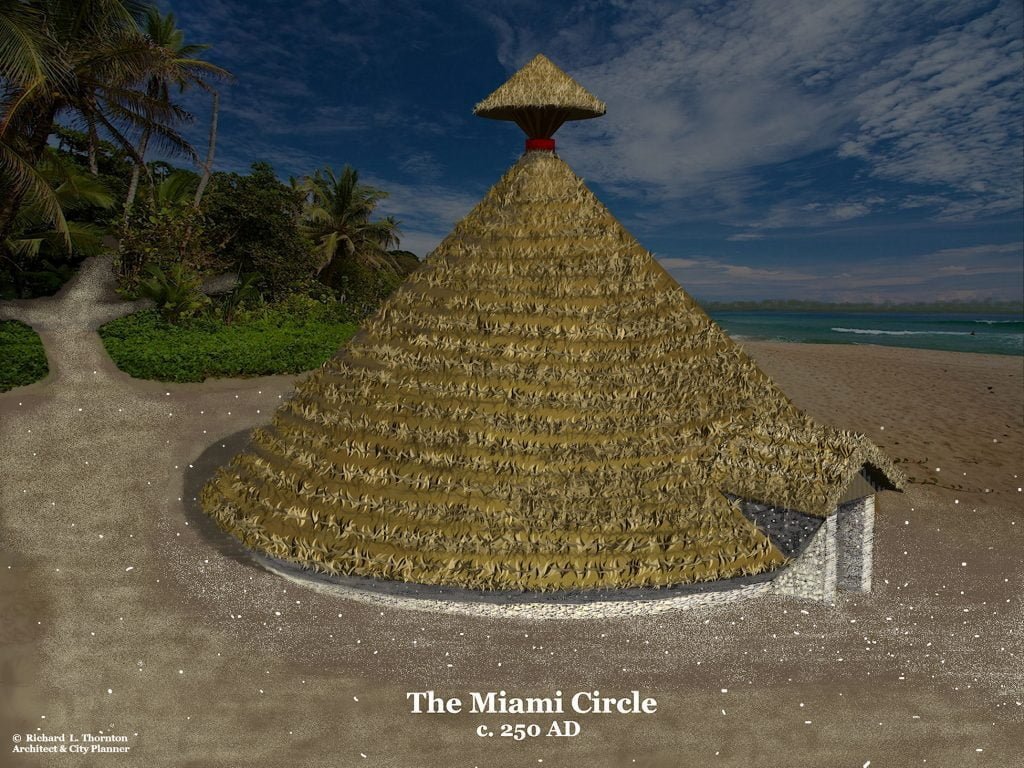The Miami Circle was discovered in 1998 during excavation for the construction of a luxury condominium at Brickell Point in Downtown Miami near the Miami River and Biscayne Bay. 1 The developer, Michael Baumann, tore down an existing apartment complex in 1998. Prior to initiating construction of the new tower, he was required to retain archaeologists to carry out a brief field survey the site by the city’s historic preservation ordinance. However, Baumann did not do this until pressured by the Miami-Dade Historic Preservation Division Director, Bob Carr, pressured him to do so. The survey was actually carried out by municipal employees, volunteers and members of the Archaeological & Historical Conservancy. Afterward, the 2.2 acre site was designated Miami Midden No. 2 or 8DA1212. 2
During what was intended to be a brief survey consisting of random post hole size pits, a volunteer came upon an ancient hole cut into the soft Oolithic limestone bedrock that was rectangular and about two feet deep. 2 More holes were discovered after Carr directed further exploration. A pattern appeared. A surveyor, Ted Riggs, suspected that the team had found a circular pattern, 38 feet (12 m) in diameter. He did this by calculating the center associated with the uncovered holes. Using CADD, he then projected the probable locations of the other holes. Excavation soon revealed that there were 24 holes forming a perfect circle.

The structure is currently estimated to have been built at some time between 0 AD and 300 AD. 1 This estimate is based on radiocarbon dating of decomposed wood particles found inside several of the holes in the limestone. Opponents of this interpretation argue that old wood particles had washed into the slots and that the Miami Circle was much younger.
When the public first heard about the discovery of a 38 feet diameter circle at Brickell Point and its radiocarbon date, there were claims that it was “an Olmec or Maya city.” Even professional archaeologists publicly stated that there were no other permanent towns north of Mexico at that time and so the Miami Circle was the oldest known permanent habitation in North America. That is not correct. Poverty Point in northern Louisiana was begun around 1,600 BC. By 0 AD there were many permanent agricultural villages in northern and central Georgia.
There are hundreds of smaller holes within and outside the main structure. 1 Artifacts, typical of a maritime hunter-gatherer culture, such as the Tekesta Indians of southeast Florida, were found in the soil above the stone foundation. The only exceptions were three stone axes, said to be made from basalt, a type of igneous stone not found in Florida.
Dr. Jacqueline Dixon, of the University of Miami, reported that the basalt was likely from the region of Macon, Georgia, some 600 miles away. 1 There is no basalt around Macon, but there are deposits farther north near Atlanta. Basalt is a very poor material for making axes and wedges because it fractures easily and cannot be worked to a fine blade. Dixon based her comments on the similarity of the axes to those found at Ocmulgee National Monument in Macon. However, those axes were greenstone and they came from the region around Dahlonega, GA, 140 miles north of Macon in the Georgia Mountains. 3 During Pre-European times, the Dahlonega area exported greenstone wedges and axed to Native peoples throughout eastern North America.
Professional and public controversies

From the moment of its discovery, the Miami Circle has been the focus of much controversy, both within the archaeological community and in the Miami political scene. Florida anthropologists generally agree that the structure was built by the Tekesta Indians, mainly because the artifacts associated with fishing, that were found near the stone surface of the Miami were typical of the Tekesta. 1 However, such primitive tools ar

